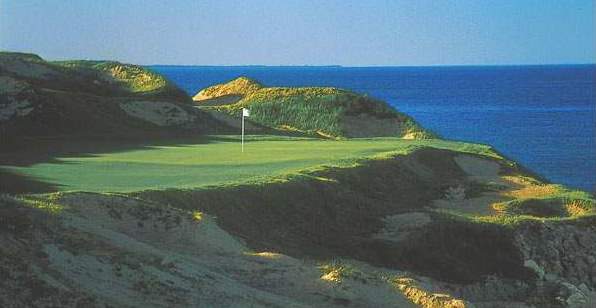Whistling Straits is one of the most celebrated golf courses opened in America in the last two decades, and I am looking forward to watching the PGA championship on it this week. But I can’t quite fall in love with the venue. I have a problem symbolized by a cow.
The bovine in question emitted a melodic, baritone moo one day while I was standing on the tee of the 13th hole at the Irish Course, Whistling Straits’ adjacent sister layout in Haven, Wisconsin. No. 13 is called, on the scorecard, Blind Man’s Bluff. That’s because there is a towering sandhill in front and just to the right of the tee, covered with wavy fescue grass. Depending on the hole location, the hill can make the flag completely invisible to the golfer standing on the tee.
The hole is supposed to bring to mind some of the classic blind holes in Ireland and Scotland, like the famous Dell at Lahinch, a par three where the player aims at a white rock atop a dune and can’t even see the green. As I was standing on the tee, trying to figure out where to aim, I heard the cow and turned around to look.
Beyond a fence I saw a perfectly flat pasture, containing the aforementioned cow. Looking around, I realized that the flat pasture typified the natural terrain as far as my eyes could see. And I understood what an artifice the golf course I was playing really was.
When Herb Kohler, the owner of the American Club Resort, took over an abandoned military installation on the shores of Lake Michigan, he took over a flat piece of land. He told Pete Dye he wanted a pair of courses that would bring to mind the heaving, seaside links courses of the Old World. Dye gave him what he ordered.
Fleets of dump trucks delivered countless cubic yards of soil and sand to the shores of Lake Michigan during the courses’ construction. They completely transformed the landscape. Whistling Straits is as natural on the shores of Lake Michigan as Space Mountain is in the erstwhile orange groves of Anaheim.
Why should this bother me? If Pete Dye built a blind par three on flat ground, why should it be any less enjoyable than the Dell hole at Lahinch? (And I liked playing the Dell hole at Lahinch, even though I left my tee shot on top of the dune and made bogey.)
I am not a dogmatic minimalist when it comes to golf course architecture. In fact, I tend to think that most so-called minimalist architects are really just architects whose clients don’t have the money to pay for lots of dump trucks and bulldozers. I understand that the humps and rolls of the greens at Pinehurst No. 2 were placed there not by God but by Donald Ross, and I know Pinehurst is a classic.
I think my unease has to do with the scale of Whistling Straits’ inauthenticity. I don’t mind playing over a sandhill that was put in my way by God and left there by an architect who probably didn’t have any way to move it, even if he’d wanted to. When the sandhill was trucked in and put there by an architect who wanted to tart up a dull piece of ground, it feels a bit too faux.
Nevertheless, I am going to enjoy watching the PGA. When I look at the golf course, I am going to try to savor the tough challenges Dye has given the players and their response to those challenges. I am going to do my best not to think of Joe Biden’s hair.

